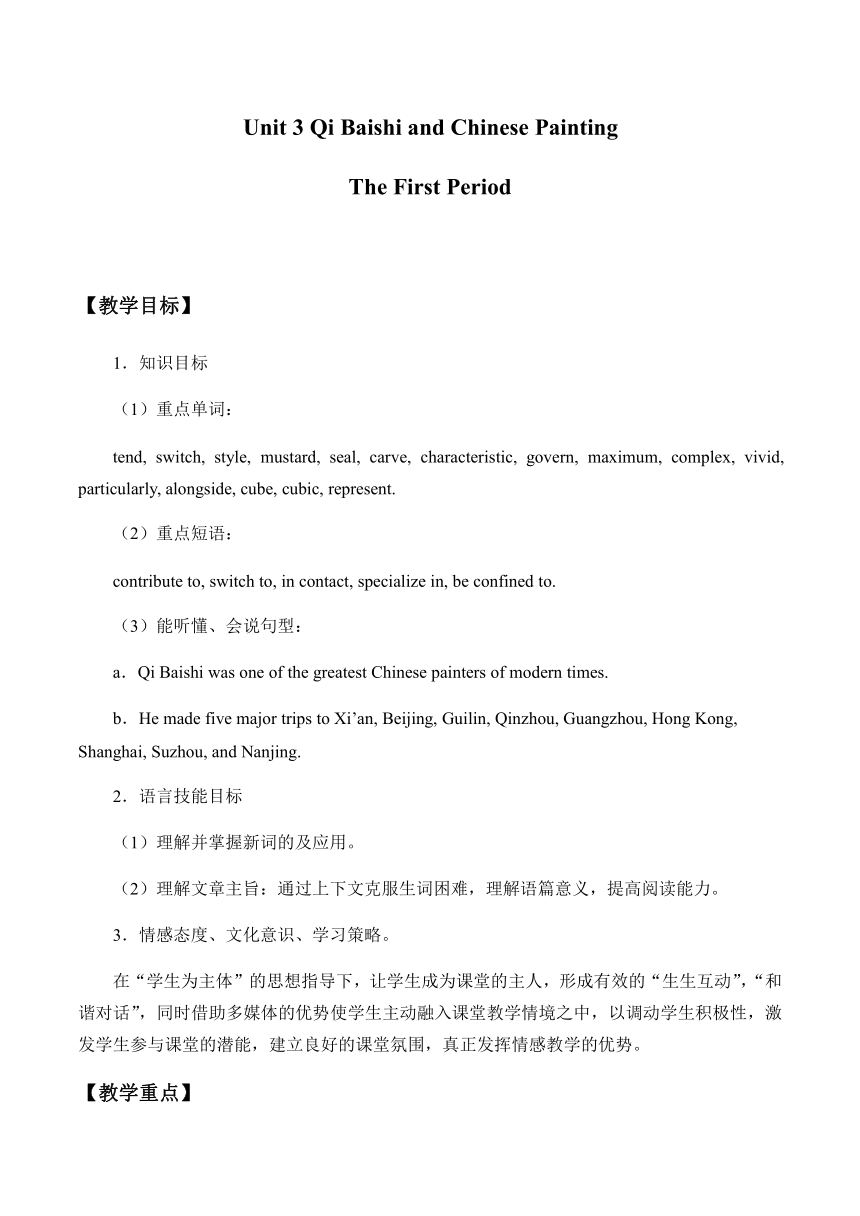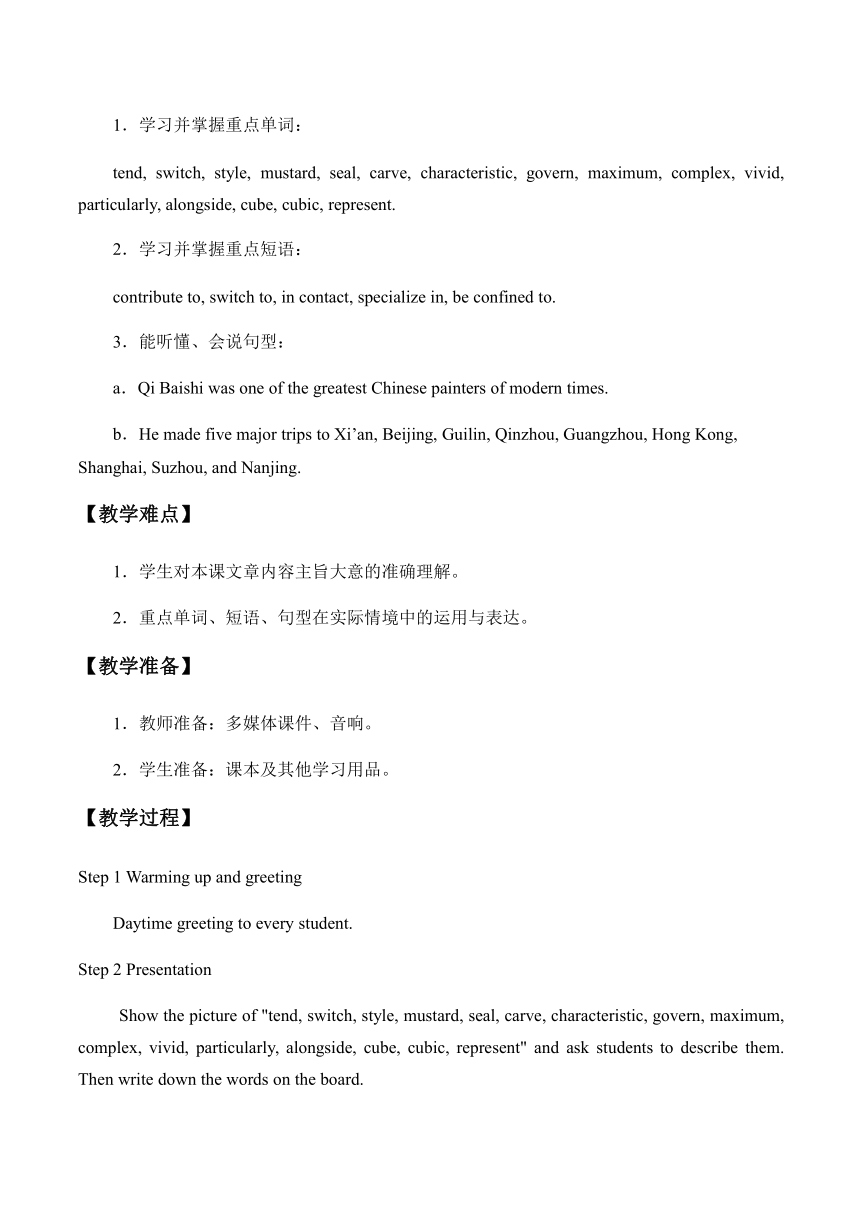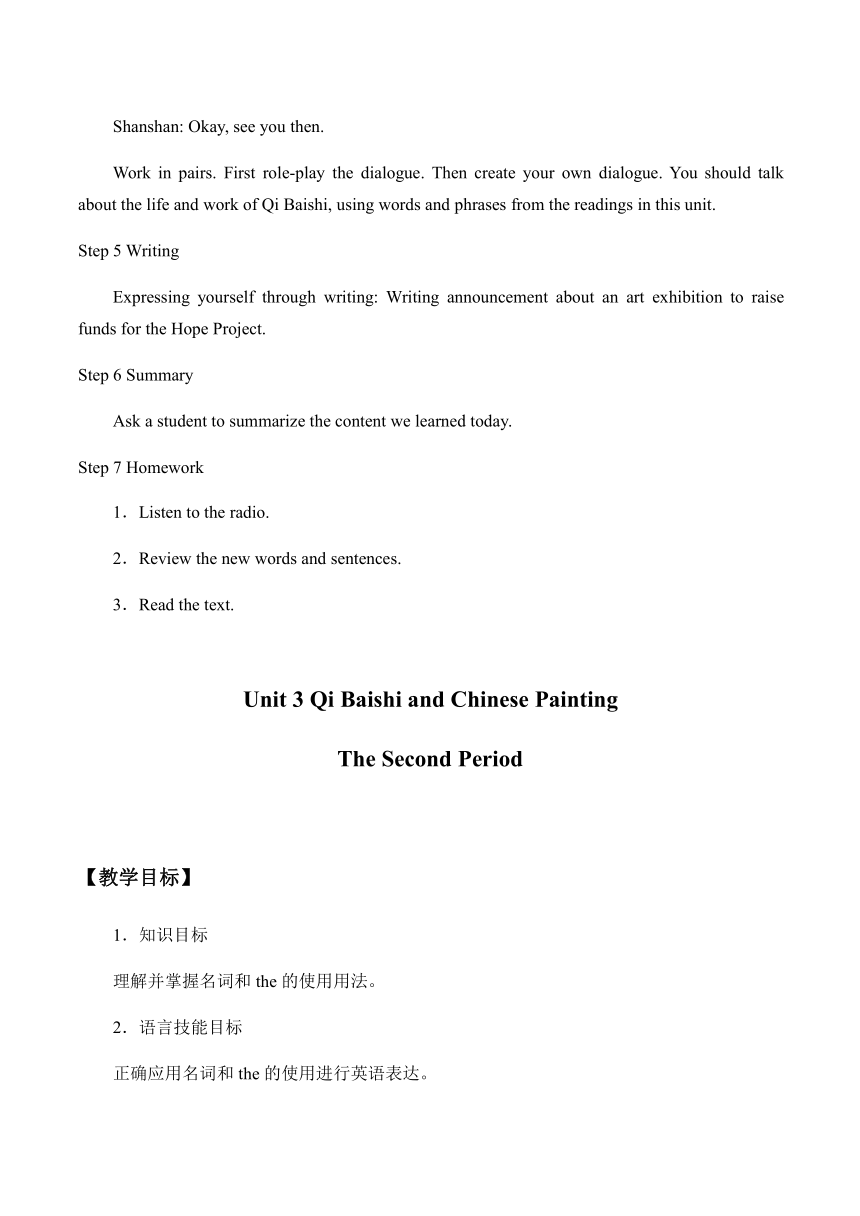冀教版选修七Unit 3 Qi Baishi and Chinese Painting 教案
文档属性
| 名称 | 冀教版选修七Unit 3 Qi Baishi and Chinese Painting 教案 |

|
|
| 格式 | zip | ||
| 文件大小 | 33.5KB | ||
| 资源类型 | 教案 | ||
| 版本资源 | 冀教版 | ||
| 科目 | 英语 | ||
| 更新时间 | 2020-02-22 20:58:58 | ||
图片预览




文档简介
Unit 3 Qi Baishi and Chinese Painting
The First Period
【教学目标】
1.知识目标
(1)重点单词:
tend, switch, style, mustard, seal, carve, characteristic, govern, maximum, complex, vivid, particularly, alongside, cube, cubic, represent.
(2)重点短语:
contribute to, switch to, in contact, specialize in, be confined to.
(3)能听懂、会说句型:
a.Qi Baishi was one of the greatest Chinese painters of modern times.
b.He made five major trips to Xi’an, Beijing, Guilin, Qinzhou, Guangzhou, Hong Kong, Shanghai, Suzhou, and Nanjing.
2.语言技能目标
(1)理解并掌握新词的及应用。
(2)理解文章主旨:通过上下文克服生词困难,理解语篇意义,提高阅读能力。
3.情感态度、文化意识、学习策略。
在“学生为主体”的思想指导下,让学生成为课堂的主人,形成有效的“生生互动”,“和谐对话”,同时借助多媒体的优势使学生主动融入课堂教学情境之中,以调动学生积极性,激发学生参与课堂的潜能,建立良好的课堂氛围,真正发挥情感教学的优势。
【教学重点】
1.学习并掌握重点单词:
tend, switch, style, mustard, seal, carve, characteristic, govern, maximum, complex, vivid, particularly, alongside, cube, cubic, represent.
2.学习并掌握重点短语:
contribute to, switch to, in contact, specialize in, be confined to.
3.能听懂、会说句型:
a.Qi Baishi was one of the greatest Chinese painters of modern times.
b.He made five major trips to Xi’an, Beijing, Guilin, Qinzhou, Guangzhou, Hong Kong, Shanghai, Suzhou, and Nanjing.
【教学难点】
1.学生对本课文章内容主旨大意的准确理解。
2.重点单词、短语、句型在实际情境中的运用与表达。
【教学准备】
1.教师准备:多媒体课件、音响。
2.学生准备:课本及其他学习用品。
【教学过程】
Step 1 Warming up and greeting
Daytime greeting to every student.
Step 2 Presentation
Show the picture of "tend, switch, style, mustard, seal, carve, characteristic, govern, maximum, complex, vivid, particularly, alongside, cube, cubic, represent" and ask students to describe them. Then write down the words on the board.
Step 3 Reading
First reading: ask students to read the passage "The Artist Qi Baishi" and find out the words that they don't know. Then teacher explains the words that they don't know.
Second reading: ask students to listen to the tape and read it again and think about the following questions:
(1)Who is Qi Baishi?
(2)What do you know about him?
Then ask students to answer the questions.
Third reading: read the passage again and finish exercises in section 2.
Step 4 Non-stop talk
1.Ask students to study the passage in groups.
2.Let’s talk: Inviting someone to an art exhibition.
3.Read the following dialogue between Li Ming and Shanshan. There is an art exhibition in town this Saturday. Li Ming has two tickets and he would like to go with someone. He meets Shanshan on his way home from school.
Li Ming: Hi, Shanshan.
Shanshan: Hi, Li Ming.
Li Ming: I was wondering if you were doing anything this Saturday. I have tickets to an art exhibition.
Shanshan: Which one?
Li Ming: I have two tickets to see the Qi Baishi Art Exhibition. Would you like to go with me?
Shanshan: Oh, I’d love to!
Li Ming: Great! I’ll see you Saturday.
Shanshan: Okay, see you then.
Work in pairs. First role-play the dialogue. Then create your own dialogue. You should talk about the life and work of Qi Baishi, using words and phrases from the readings in this unit.
Step 5 Writing
Expressing yourself through writing: Writing announcement about an art exhibition to raise funds for the Hope Project.
Step 6 Summary
Ask a student to summarize the content we learned today.
Step 7 Homework
1.Listen to the radio.
2.Review the new words and sentences.
3.Read the text.
Unit 3 Qi Baishi and Chinese Painting
The Second Period
【教学目标】
1.知识目标
理解并掌握名词和the的使用用法。
2.语言技能目标
正确应用名词和the的使用进行英语表达。
3.情感态度、文化意识、学习策略
在“学生为主体”的思想指导下,让学生成为课堂的主人,形成有效的“生生互动”,“和谐对话”,同时借助多媒体的优势使学生主动融入课堂教学情境之中,以调动学生积极性,激发学生参与课堂的潜能,建立良好的课堂氛围,真正发挥情感教学的优势。
【教学重点】
名词和the的使用的讲解。
【教学难点】
名词和the的使用的理解与掌握。
【教学准备】
1.教师准备:多媒体课件、音响。
2.学生准备:课本及其他学习用品。
【教学过程】
Step 1 Warming up and greeting
Daytime greeting to every student.
Step 2 Presentation
1.As you know, nouns can be divided into two major types: common nouns and proper nouns.
(1)Proper nouns that are composed of common nouns along with proper nouns.
(2)A proper noun that has a particular meaning or is specifically modified.
2.In general, "the" is not used before a proper noun. In the following cases, however, "the" should be used:
(1)Names of mountain ranges and groups of islands.
(2)Names of rivers, seas and oceans.
(3)Names of straits and bays.
Ask students to memorize this part for ten minus and then ask them to close books to explain the grammar from this part as many as possible.
Step 3 Danny's grammar questions:
1.Look at this sentence: "It is said that by the age of 7, Qi had learned about 300 Chinese characters." Why does the writer use "had learned" instead of "learned" or "was learning?"
2.In the sentence "Qi once said of himself..." why does the author use "of?" What does "of"' mean here?
After the discussion, students summarize the answers to the questions and make group presentations, then prepare to be evaluated by the teacher.
Step 4 Fun of the Unit!
Enjoy those fun stories in the book.
Step 5 Summary and Homework
Ask a student to summarize the grammar we learned today, and to finish other exercises this part in book.
Unit 3 Qi Baishi and Chinese Painting
The Third Period
【教学目标】
1.知识目标
(1)重点单词:
changeable, arbitrary, arch, psychology, liberation, civilian, target, adore, signature.
(2)重点短语:
put emphasis on, attach to, bark up the wrong tree, be fascinated with.
2.语言技能目标
(1)理解并掌握新词的及应用。
(2)理解文章主旨:通过上下文克服生词困难,理解语篇意义,提高阅读能力。
3.情感态度、文化意识、学习策略。
在“学生为主体”的思想指导下,让学生成为课堂的主人,形成有效的“生生互动”,“和谐对话”,同时借助多媒体的优势使学生主动融入课堂教学情境之中,以调动学生积极性,激发学生参与课堂的潜能,建立良好的课堂氛围,真正发挥情感教学的优势。
【教学重点】
1.学习并掌握重点单词:
changeable, arbitrary, arch, psychology, liberation, civilian, target, adore, signature.
2.学习并掌握重点短语:
put emphasis on, attach to, bark up the wrong tree, be fascinated with.
【教学难点】
1.学生对本课文章内容主旨大意的准确理解。
2.重点单词、短语、句型在实际情境中的运用与表达。
【教学准备】
1.教师准备:多媒体课件、音响。
2.学生准备:课本及其他学习用品。
【教学过程】
Step 1 Warming up and greeting
Daytime greeting to every student.
Step 2 Presentation
Show the picture of "changeable, arbitrary, arch, psychology, liberation, civilian, target, adore, signature" and ask students to describe them. Then write down the words on the board.
Step 3 Reading
First reading: ask students to read the passage "Chinese Artists" and find out the words that they don't know. Then teacher explains the words that they don't know.
Second reading: ask students to listen to the tape and read it again and think about the following questions:
(1)Have you heard of Zhang Daqian and Pan Tianshou?
(2)How much do you know about Chinese paintings and Chinese artists?
Then ask students to answer the questions.
Read the passage "Pablo Picasso" and think about the following questions. Then teacher explains the words that they don't know.
(1)Why is Picasso regarded as the greatest artist in the West?
(2)Can you name some of his greatest works?
After the students have finished thinking about the problems, teacher emphasizes the important point or asks the students to answer the questions and checks the answers.
Step 4 Practice
Finish the Danny’s quiz in P36.
Step 5 Summary
Ask a student to summarize the content we learned today.
Step 6 Homework
1.Listen to the radio.
2.Review the new words and sentences.
3.Read the text.
